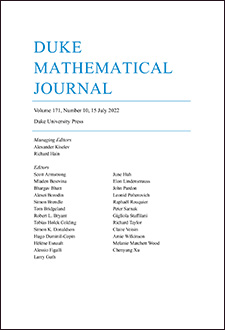Abstract
Given a regular function $H\colon\mathbb{R}^{3}\to\mathbb{R}$, we look for $H$-bubbles, that is, regular surfaces in $\mathbb{R}^{3}$ parametrized on the sphere $\mathbb{S}+^{2}$ with mean curvature $H$ at every point. Here we study the case of $H(u)=H_{0}+\varepsilon H_{1}(u)=:H_{\varepsilon}(u)$, where $H_{0}$ is a nonzero constant, $\varepsilon$ is the smallness parameter, and $H_{1}$ is any $C^{2}$-function. We prove that if $\bar p\in\mathbb{R}^{3}$ is a ``good'' stationary point for the Melnikov-type function $\Gamma(p)=-\int_{|q-p|<|H_{0}|^{-1}}H_{1}(q)\,dq$, then for $|\varepsilon|$ small there exists an $H_{\varepsilon}$-bubble $\omega^{\varepsilon}$ that converges to a sphere of radius $|H_{0}|^{-1}$ centered at $\bar p$, as $\varepsilon\to 0$.
Citation
Paolo Caldiroli. Roberta Musina. "H-bubbles in a perturbative setting: The finite-dimensional reduction method." Duke Math. J. 122 (3) 457 - 484, 15 April 2004. https://doi.org/10.1215/S0012-7094-04-12232-8
Information





